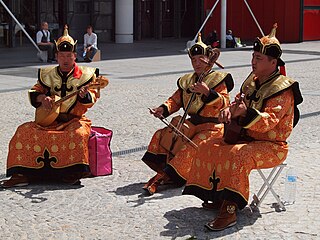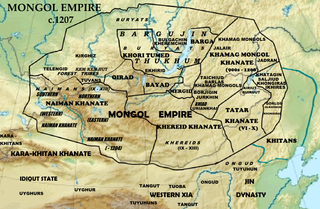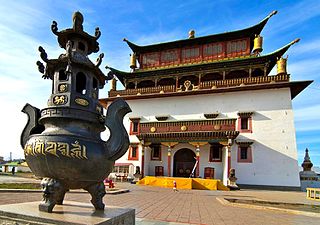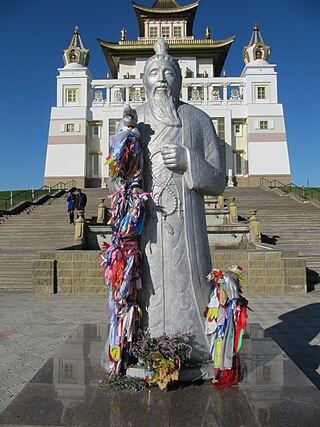Related Research Articles

The Mongols are an East Asian ethnic group native to Mongolia, China, as well as Buryatia and Kalmykia republics of Russia. The Mongols are the principal member of the large family of Mongolic peoples. The Oirats and the Buryats are classified either as distinct ethno-linguistic groups or subgroups of Mongols.
Articles related to Mongolia include:

Khövsgöl is the northernmost of the 21 aimags (provinces) of Mongolia. The name is derived from Lake Khövsgöl.

Tsagaannuur is a sum of Khövsgöl aimag. The area is 5,410 km2. In 2000, Tsagaannuur had a population of 1,317 people, of which most identified themselves as Darkhad. There were 269 inhabitants who identified themselves as Tsaatan ethnicity. The sum center, officially named Gurvansaikhan, is located at the shore of Dood Tsagaan Lake.

Renchinlkhümbe is a sum of Khövsgöl Province in Mongolia. The area is about 8,850 square kilometres (3,420 sq mi), of which 2,910 square kilometres (1,120 sq mi) are pasture and 35% are forest. In 2000, the sum had 4284 inhabitants, mainly Darkhad. The sum center, officially named Zöölön, is 265 kilometres (165 mi) north of Mörön and 998 kilometres (620 mi) from Ulaanbaatar.

Tengrism is a religion originating in the Eurasian steppes, based on shamanism and animism. It generally involves the titular sky god Tengri, who is not considered a deity in the usual sense but a personification of the universe. According to some scholars, adherents of Tengrism view the purpose of life to be in harmony with the universe.

Uriankhai is a term of address applied by the Mongols to a group of forest peoples of the North, who include the Turkic-speaking Tuvans and Yakuts, while sometimes it is also applied to the Mongolian-speaking Altai Uriankhai. The Uriankhai included the western forest Uriankhai tribe and the Transbaikal Uriankhai tribe, with the former recorded in Chinese sources as Chinese: 兀良哈; pinyin: Wùliánghā).

Ulaan-Uul is a sum of Khövsgöl aimag. The area is close to 10,000 km2. In 2000, Ulaan-Uul had a population of 3,726 people, mainly Darkhad. The sum center, officially named Tögöl, is located 171 km north-north-west of Mörön and 942 km from Ulaanbaatar.

The Darkhad, Darqads, or Darhut (Mongolian for "Blacksmiths","Workmen" are a subgroup of Mongol people living mainly in northern Mongolia, in the Bayanzürkh, Ulaan-Uul, Renchinlkhümbe, Tsagaannuur sums of Khövsgöl Province; The Darkhad valley is named after them. The regional variant of Mongol language is the Darkhad dialect. In the 2000 census, 16,268 people identified themselves as Darkhad.

Religion in Mongolia has been traditionally dominated by the schools of Mongolian Buddhism and by Mongolian shamanism, the ethnic religion of the Mongols. Historically, through their Mongol Empire the Mongols were exposed to the influences of Christianity and Islam, although these religions never came to dominate. During the communist period of the Mongolian People's Republic (1924–1992) all religions were suppressed, but with the transition to the parliamentary republic in the 1990s there has been a general revival of faiths.

Mongolian shamanism, known as the Böö Mörgöl in Mongolian and more broadly called the Mongolian folk religion or occasionally Tengerism, refers to the animistic and shamanic ethnic religion that has been practiced in Mongolia and its surrounding areas at least since the age of recorded history. In the earliest known stages it was intricately tied to all other aspects of social life and to the tribal organization of Mongolian society. Along the way, it has become influenced by and mingled with Buddhism. During the socialist years of the twentieth century, it was heavily repressed, but has since made a comeback.
In the pantheon of Mongolian shamanism and Tengrism, tngri constitute the highest class of divinities and are attested in sources going back to the 13th century. They are led by different chief deities in different documents and are divided into a number of different groups—including black (terrifying) and white (benevolent), and eastern and western. While there generally seem to be 99 tngri, some documents propose three others, and while they are generally the highest divinities, some liturgical texts propose an additional group of 33 chief gods alongside the tngri. They were invoked only by the highest shamans and leaders for special occasions; they continue to be venerated especially in black shamanism. Chief among the tngri are Qormusata Tngri and (Khan) Möngke Tngri.

Tsagaan Ubgen is the Mongolian guardian of life and longevity, one of the symbols of fertility and prosperity in the Buddhist pantheon. He is worshiped as a deity in what scholars have called "white shamanism", a subdivision of what scholars have called "Buryat yellow shamanism"—that is, a tradition of shamanism that "incorporate[s] Buddhist rituals and beliefs" and is influenced specifically by Tibetan Buddhism. Sagaan Ubgen originated in Mongolia.
Yellow shamanism is the term used to designate a particular version of shamanism practiced in Mongolia and Siberia which incorporates rituals and traditions from Buddhism. "Yellow" indicates Buddhism in Mongolia, since most Buddhists there belong to what is called the "Yellow sect" of Tibetan Buddhism, whose members wear yellow hats during services. The term also serves to distinguish it from a form of shamanism not influenced by Buddhism, called "black shamanism".
Dayan Deerh or Dayan Degereki is one of the most important divinities in the folk practices and shamanic invocations in Khövsgöl Province, Mongolia. His cult is linked to fertility rites which are practiced in yellow shamanism as well as in black shamanism. He is still venerated, especially on the eastern side of Lake Khövsgöl.
Black shamanism is a kind of shamanism practiced in Mongolia and Siberia. It is specifically opposed to yellow shamanism, which incorporates rituals and traditions from Buddhism. Black Shamans are usually perceived as working with evil spirits, while white Shamans with spirits of the upper world.
Daichsun Tngri, also known as Dayisud Tngri and Dayičin Tngri, is a Mongolian war god "of a protective function" to whom captured enemies were sometimes sacrificed. One of the equestrian deities within the Mongolian pantheon of 99 tngri, Dayisun Tngri may appear as a mounted warrior. Some of his characteristics may be the result of the "syncretistic influence of Lamaism" ; the 5th Dalai Lama composed invocations to this deity.

Sülde Tngri is an equestrian war god, one of the tngri, the highest group of divinities in Mongolian shamanism and Buddhism. He is usually depicted as an armored warrior riding a horse. In Mongolian shamanism, everyone possesses a guardian spirit, called a sülde. "Sülde Tngri" can refer to the sülde of any great leader, but it primarily refers to the deified sülde of Genghis Khan. As a war god, Sülde Tngri's primary function is protecting his devotees from their enemies and aiding them in battles against their foes.

Religion in Inner Mongolia is characterised by the diverse traditions of Mongolian-Tibetan Buddhism, Chinese Buddhism, the Chinese traditional religion including the traditional Chinese ancestral religion, Taoism, Confucianism and folk religious sects, and the Mongolian native religion. The region is inhabited by a majority of Han Chinese and a substantial minority of Southern Mongols, so that some religions follow ethnic lines.
References
- ↑ Pedersen 2011 , p. xii
- ↑ Pedersen 2011 , p. 166
- ↑ Shimamura 2004 , p. 546
- ↑ Birtalan 2011
- ↑ Birtalan 2011 , p. 26
- ↑ Shimamura 2004 , p. 651
- ↑ Shimamura 2004 , p. 650
- ↑ Pegg 2001 , pp. 127–28
- ↑ Pegg 2001 , p. 121
- ↑ Pedersen 2011 , p. 167
- ↑ Pedersen 2011 , p. 13
- ↑ Pedersen 2011 , p. 158